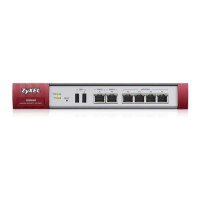Chapter 16 Interfaces
ZyWALL Series CLI Reference Guide
158
The following table identifies the values required for many of these commands. Other input values are
discussed with the corresponding commands.
This table lists the LAG-specific interface commands. See Table 53 on page 121 for common interface
commands.
Table 75 Input Values for LAG Interface Commands
LABEL DESCRIPTION
interface_name
LAG interface: lagx, x = 0 - 4 (at the time of writing).
Ethernet interface: For some Zyxel Device models use gex, x = 1 - N, where N equals the
highest numbered Ethernet interface for your Zyxel Device model.
For other Zyxel Device models use a name such as wan1, wan2, opt, lan1, ext-wlan, or
dmz.
VLAN interface: vlanx, x = 0 - 4094
Table 76 interface Commands: LAG Interfaces
COMMAND DESCRIPTION
interface interface_name
Creates the specified LAG interface (lag0 for example) and enters sub-
command mode.
traffic-prioritize
{tcp-ack|content-
filter|dns} bandwidth
<0..1048576>];
Applies traffic priority when the interface sends TCP-ACK traffic, traffic for
querying the content filter, or traffic for resolving domain names. It also sets
how much bandwidth the traffic can use.
traffic-prioritize
{tcp-ack|content-
filter|dns} priority-
code <0..7>
deactivate
Turns off traffic priority settings for when the interface sends the specified
type of traffic.
mode {802_3ad |
active-backup |
balance-alb | mode
802_3ad}
Sets the LAG mode. Mode refers to whether the LAG is acting as follows:
• active-backup where only one slave in the LAG interface is active and
another slave becomes active only if the active slave fails.
• 802.3ad (IEEE 802.3ad Dynamic link aggregation) where Link
Aggregation Control Protocol (LACP) negotiates automatic combining
of links and balances the traffic load across the LAG link by sending LACP
packets to the directly connected device that also implements LACP.
The slaves must have the same speed and duplex settings.
• balance-alb (adaptive load balancing) where traffic is distributed
according to the current load on each slave by ARP negotiation.
Incoming traffic is received by the current slave. If the receiving slave
fails, another slave takes over the MAC address of the failed receiving
slave.
[no] slave
interface_name
Specifies the member ports in the link. A slave is a physical Ethernet interface
that is a member of a LAG. Slaves do not have an IP Address and in some
cases share the same MAC address.
The no command removed the member ports from the link.
link-monitoring {arp
| mii | none}
Sets link monitoring to be arp, mii or none.
• arp monitoring sends ARP queries and uses the reply to know if the link is
up and that traffic is flowing over the link
• mii monitoring monitors the state of the local interface; it can’t tell if the
link can transmit or receive packets.
• none means no link monitoring is done.

